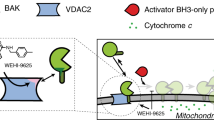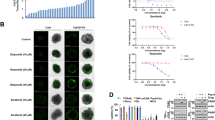Abstract
Mutation and aberrant expression of apoptotic proteins are hallmarks of cancer. These changes prevent proapoptotic signals from being transmitted to executioner caspases, thereby averting apoptotic death and allowing cellular proliferation. Caspase-3 is the key executioner caspase, and it exists as an inactive zymogen that is activated by upstream signals. Notably, concentrations of procaspase-3 in certain cancerous cells are significantly higher than those in noncancerous controls. Here we report the identification of a small molecule (PAC-1) that directly activates procaspase-3 to caspase-3 in vitro and induces apoptosis in cancerous cells isolated from primary colon tumors in a manner directly proportional to the concentration of procaspase-3 inside these cells. We found that PAC-1 retarded the growth of tumors in three different mouse models of cancer, including two models in which PAC-1 was administered orally. PAC-1 is the first small molecule known to directly activate procaspase-3 to caspase-3, a transformation that allows induction of apoptosis even in cells that have defective apoptotic machinery. The direct activation of executioner caspases is an anticancer strategy that may prove beneficial in treating the many cancers in which procaspase-3 concentrations are elevated.
This is a preview of subscription content, access via your institution
Access options
Subscribe to this journal
Receive 12 print issues and online access
$259.00 per year
only $21.58 per issue
Buy this article
- Purchase on Springer Link
- Instant access to full article PDF
Prices may be subject to local taxes which are calculated during checkout





Similar content being viewed by others
References
Hanahan, D. & Weinberg, R.A. The hallmarks of cancer. Cell 100, 57–70 (2000).
Lowe, S.W., Cepero, E. & Evan, G. Intrinsic tumor suppression. Nature 432, 307–315 (2004).
Vogelstein, B. & Kinzler, K.W. Achilles' heel of cancer. Nature 412, 865–866 (2001).
Traven, A., Huang, D.C. & Lithgow, T. Protein hijacking: key proteins held captive against their will. Cancer Cell 5, 107–108 (2004).
Soengas, M.S. et al. Inactivation of the apoptosis effector Apaf-1 in malignant melanoma. Nature 409, 207–211 (2001).
Wajant, H. Targeting the FLICE inhibitory protein (FLIP) in cancer therapy. Mol. Interv. 3, 124–127 (2003).
Okada, H. & Mak, T.W. Pathways of apoptotic and non-apoptotic death in tumour cells. Nat. Rev. Cancer 4, 592–603 (2004).
Denicourt, C. & Dowdy, S.F. Targeting apoptotic pathways in cancer cells. Science 305, 1411–1413 (2004).
Green, D.R. & Kroemer, G. Pharmacological manipulation of cell death: clinical applications in sight? J. Clin. Invest. 115, 2610–2617 (2005).
Vassilev, L.T. et al. In vivo activation of the p53 pathway by small-molecule antagonists of MDM2. Science 303, 844–848 (2004).
Degterev, A. et al. Identification of small-molecule inhibitors of interaction between the BH3 domain and Bcl-XL. Nat. Cell Biol. 3, 173–182 (2001).
Becattini, B. et al. Rational design and real time, in-cell detection of the proapoptotic activity of a novel compound targeting Bcl-XL. Chem. Biol. 11, 389–395 (2004).
Wang, J.-L. et al. Structure-based discovery of an organic compound that binds Bcl-2 protein and induces apoptosis of tumor cells. Proc. Natl. Acad. Sci. USA 97, 7124–7129 (2000).
Li, L. et al. A small molecule Smac mimic potentiates TRAIL- and TNFalpha-mediated cell death. Science 305, 1471–1474 (2004).
Nguyen, J.T. & Wells, J.A. Direct activation of the apoptosis machinery as a mechanism to target cancer cells. Proc. Natl. Acad. Sci. USA 100, 7533–7538 (2003).
Jiang, X. et al. Distinctive roles of PHAP proteins and prothymosin-α in a death regulatory pathway. Science 299, 223–226 (2003).
Boatright, K.M. & Salvesen, G.S. Mechanisms of caspase activation. Curr. Opin. Cell Biol. 15, 725–731 (2003).
Roy, S. et al. Maintenance of caspase-3 proenzyme dormancy by an intrinsic “safety catch” regulatory tripeptide. Proc. Natl. Acad. Sci. USA 98, 6132–6137 (2001).
Nakagawara, A. et al. High levels of expression and nuclear localization of interleukin-1 β converting enzyme (ICE) and CPP32 in favorable human neuroblastomas. Cancer Res. 57, 4578–4584 (1997).
Izban, K.F. et al. Characterization of the interleukin-1β-converting enzyme/Ced-3-family protease, caspase-3/CPP32, in Hodgkin's disease. Am. J. Pathol. 154, 1439–1447 (1999).
Estrov, Z. et al. Caspase 2 and caspase 3 protein levels as predictors of survival in acute myelogenous leukemia. Blood 92, 3090–3097 (1998).
Fink, D. et al. Elevated procaspase levels in human melanoma. Melanoma Res. 11, 385–393 (2001).
Persad, R. et al. Overexpression of caspase-3 in hepatocellular carcinomas. Mod. Pathol. 17, 861–867 (2004).
Svingen, P.A. et al. Components of the cell death machine and drug sensitivity of the National Cancer Institute Cell Line Panel. Clin. Cancer Res. 10, 6807–6820 (2004).
Pop, C., Feeney, B., Tripathy, A. & Clark, A.C. Mutations in the procaspase-3 dimer interface affect the activity of the zymogen. Biochemistry 42, 12311–12320 (2003).
Stennicke, H.R. et al. Pro-caspase-3 is a major physiologic target of caspase-8. J. Biol. Chem. 273, 27084–27090 (1998).
Denault, J.-B. & Salvesen, G.S. Human caspase-7 activity and regulation by its N-terminal peptide. J. Biol. Chem. 278, 34042–34050 (2003).
Putt, K.S., Beilman, G.J. & Hergenrother, P.J. Direct quantitation of poly(ADP-ribose) polymerase (PARP) activity as a means to distinguish necrotic and apoptotic death in cell and tissue samples. ChemBioChem 6, 53–55 (2005).
Liang, Y., Nylander, K.D., Yan, C. & Schor, N.F. Role of caspase 3-dependent Bcl-2 cleavage in potentiation of apoptosis by Bcl-2. Mol. Pharmacol. 61, 142–149 (2002).
Fujita, N., Nagahashi, A., Nagashima, K., Rokudai, S. & Tsuruo, T. Acceleration of apoptotic cell death after the cleavage of Bcl-XL protein by caspase-3-like proteases. Oncogene 17, 1295–1304 (1998).
Earnshaw, W.C., Martins, L.M. & Kaufmann, S.H. Mammalian caspases; structure, activation, substrates, and functions during apoptosis. Annu. Rev. Biochem. 68, 383–424 (1999).
Koty, P.P., Zhang, H. & Levitt, M.L. Antisense bcl-2 treatment increases programmed cell death in non-small cell lung cancer cell lines. Lung Cancer 23, 115–127 (1999).
O'Donovan, N. et al. Caspase 3 in breast cancer. Clin. Cancer Res. 9, 738–742 (2003).
Vakkala, M., Paakko, P. & Soini, Y. Expression of caspases 3, 6 and 8 is increased in parallel with apoptosis and histological aggressiveness of the breast lesion. Br. J. Cancer 81, 592–599 (1999).
Devarajan, E. et al. Down-regulation of caspase 3 in breast cancer: a possible mechanism for chemoresistance. Oncogene 21, 8843–8851 (2002).
Acknowledgements
This work was supported by the National Science Foundation (NSF CAREER award to P.J.H., CHE-0134779), the University of Illinois (to P.J.H.) and the National Institutes of Health (Grant CA77355 to W.G.H. and AG024387 to W.G.H. and D.R.D.). K.S.P. is supported by a fellowship from the American Chemical Society Division of Medicinal Chemistry. M.S.H. was supported by National Institute of Environmental Health Sciences Training Grant 5T32ES007326-05. J.T.K., S.K.H. and H.J. are recipients of a Brain Korea 21 fellowship. M.H.C. is supported by a Korea Science and Engineering Foundations (KOSEF), Ministry of Science and Technology (MOST) grant (550-20060062). We thank P. Tender and L. Tangen (Carle Foundation Hospital) for the primary colon cancer samples. We thank R. Hoffman (University of Illinois-Chicago Cancer Center) for the generous gift of human bone marrow. We thank G. Salvesen (Burnham Institute) for the gift of the procaspase-3 and procaspase-7 expression vectors. We thank D. Goode and A. Sharma (University of Illinois) for synthesis of the peptidic caspase substrate. We acknowledge the assistance of the Flow Cytometry Facility of the Biotechnology Center at the University of Illinois.
Author information
Authors and Affiliations
Contributions
K.S.P. and P.J.H. were responsible for designing the experiments and writing the manuscript. K.S.P. conducted the high-throughput screen, all in vitro and all cell culture experiments with PAC-1, and all experiments with the primary colon tumors. G.W.C. and J.M.P. assisted with the high-throughput screen. J.S.S. was responsible for the synthesis of PAC-1 and its derivatives. M.S.H. and W.G.H. evaluated PAC-1 in the ACHN xenograft model. J.T.K., S.K.H., H.J. and M.H.C. evaluated PAC-1 in the NCI-H226 xenograft models. D.R.D. and M.I.C. determined the concentrations of PAC-1 in mouse serum.
Corresponding author
Ethics declarations
Competing interests
The authors declare no competing financial interests.
Supplementary information
Supplementary Fig. 1
Western blot showing PAC-1 efficacy at 5 μM. (PDF 66 kb)
Supplementary Fig. 2
Flow cytometry data showing PAC-1 efficacy at 5 μM. (PDF 75 kb)
Supplementary Fig. 3
Graph showing that Z-VAD-FMK inhibits cell death induced by PAC-1. (PDF 22 kb)
Supplementary Fig. 4
Graph showing that PAC-1 does not inhibit PARP-1. (PDF 19 kb)
Supplementary Fig. 5
Graph showing etoposide-induced cell death does not correlate with cellular procaspase-3 concentrations. (PDF 20 kb)
Supplementary Fig. 6
Primary data showing procaspase-3 concentrations in cancerous and noncancerous colon tissue taken from 23 people. (PDF 312 kb)
Supplementary Fig. 7
Graph showing the concentration of PAC-1 in serum. (PDF 19 kb)
Supplementary Methods
All chemical and biological protocols. (PDF 202 kb)
Rights and permissions
About this article
Cite this article
Putt, K., Chen, G., Pearson, J. et al. Small-molecule activation of procaspase-3 to caspase-3 as a personalized anticancer strategy. Nat Chem Biol 2, 543–550 (2006). https://doi.org/10.1038/nchembio814
Received:
Accepted:
Published:
Issue Date:
DOI: https://doi.org/10.1038/nchembio814
This article is cited by
-
Phase I study of procaspase-activating compound-1 (PAC-1) in the treatment of advanced malignancies
British Journal of Cancer (2023)
-
Systematic and mechanistic analysis of AuNP-induced nanotoxicity for risk assessment of nanomedicine
Nano Convergence (2022)
-
Design, synthesis and evaluation of novel 2-oxoindoline-based acetohydrazides as antitumor agents
Scientific Reports (2022)
-
Time-resolved protein activation by proximal decaging in living systems
Nature (2019)
-
Protective effects of anthocyanin against apoptosis and oxidative stress induced by arsanilic acid in DF-1 cells
Molecular Biology Reports (2019)



